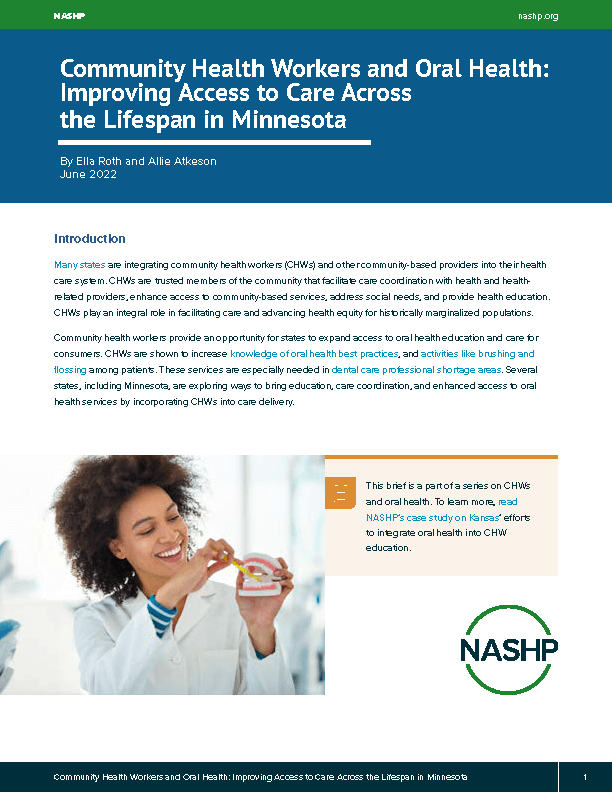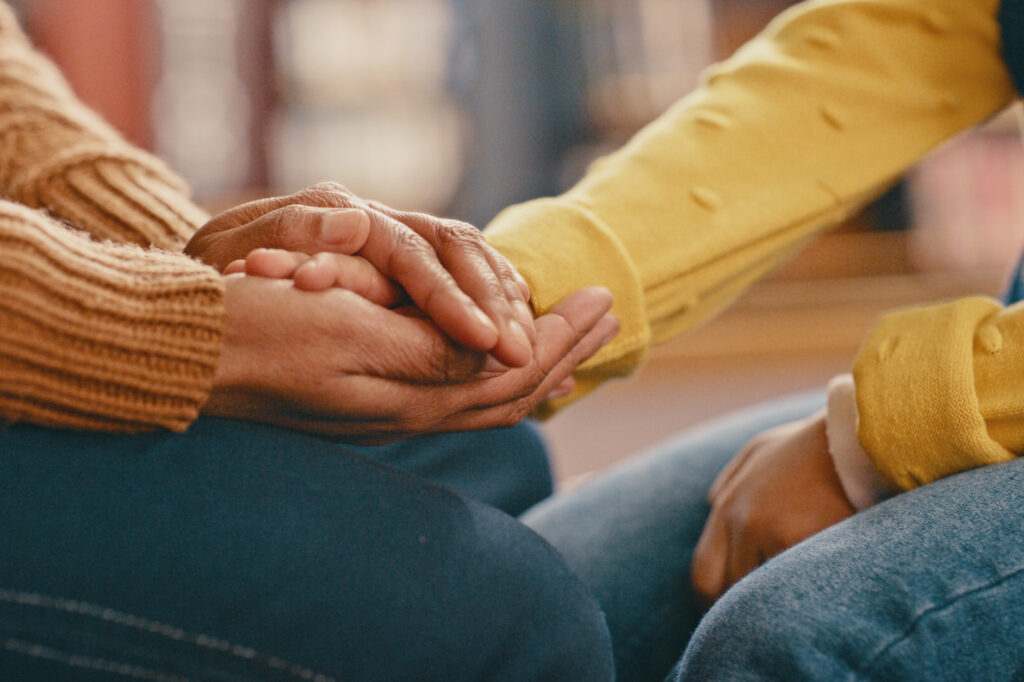Introduction
Many states are integrating community health workers (CHWs) and other community-based providers into their health care system. CHWs are trusted members of the community that facilitate care coordination with health and health-related providers, enhance access to community-based services, address social needs, and provide health education. CHWs play an integral role in facilitating care and advancing health equity for historically marginalized populations.
Community health workers provide an opportunity for states to expand access to oral health education and care for consumers. CHWs are shown to increase knowledge of oral health best practices, and activities like brushing and flossingamong patients. These services are especially needed in dental care professional shortage areas. Several states, including Minnesota, are exploring ways to bring education, care coordination, and enhanced access to oral health services by incorporating CHWs into care delivery.
Maintaining good oral health is fundamental to overall health across the lifespan, as childhood oral health can affect oral health and other health outcomes as an adult. Minnesota engages CHWs in a variety of ways to improve oral health education and access to oral health care services. Namely, Minnesota’s “Healthy Teeth. Healthy Baby.” campaign and the Healthy Brain Initiative pilot program engage CHWs to educate caregivers on oral health and coordinate access to oral health services for young children and older adults.
Youth and older adult populations experience unique challenges to accessing dental care and maintaining good oral health. While considerable attention has been devoted to promoting access to oral health care for children, older adults are also at greater risk of poor oral health due in part to the absence of a dental benefit in Medicare, a shortage of geriatric oral health care providers, and a system of care that often does not meet the needs of a growing older adult population.
Several structural barriers restrict oral health care access in the U.S., including insufficient insurance coverage, lack of dental-medical system integration, workforce shortages, and disparities in access to care and health outcomes (based on factors such as neighborhood, employment, and education). Minnesota is home to several large communities of immigrants including Hmong, Somali and Karen immigrants as well as 11 Indian tribes. Health messages are best delivered by trusted members of the community they serve, therefore, CHWs are uniquely positioned to bridge gaps in access to services and provide education on preventative dental care measures.
Community Health Workers in Minnesota
CHWs in Minnesota provide diagnosis-related patient education, health promotion, and disease management services. The Minnesota Department of Health (MDH) houses the state Oral Health Program and uses grant funding to contract with CHWs. The Oral Health Program works closely with the Minnesota CHW Alliance on curriculum, continuing education, deployment of CHWs in oral health settings, and reimbursement policy.
Minnesota’s Oral Health Program supports a number of initiatives that include CHWs with the goals of preventing tooth decay and improving oral health in communities throughout the state. In Minnesota, CHWs can also provide fluoride varnish under the supervision of a licensed medical provider under the Current Procedural Technology (CPT) code 99188 after completing an approved training course.
Healthy Teeth. Healthy Baby. Campaign
Minnesota CHWs play a key role in educating parents and caregivers and connecting young children to dental homes to prevent tooth decay. In 2015, the Minnesota Legislature called for a statewide Early Dental Disease Prevention Initiative, which prompted the Healthy Teeth. Healthy Baby. campaign. This initiative aims to prevent tooth decay in children by providing education and resources to pregnant women and caregivers of children up to the age of three. MDH provides communication materials and oral health kits through partnerships with CHWs, primary care providers, dental providers, community organizations, Head Starts, and other public health agencies, who can download the campaign communications toolkit from the MDH website. With input from community members and dental, medical and public health professionals, the initiative was designed to take a whole-person approach to addressing early childhood dental caries. Campaign messaging focuses on understanding the value of prenatal oral health, cleaning baby teeth, using fluoride to prevent cavities, feeding babies healthy food, and visiting oral health care providers early.
Pilot: Healthy Brain Initiative
People with Alzheimer’s disease and other dementias face additional difficulties maintaining good oral health due to cognitive impairment and caregiver-related challenges (such as a lack of education on addressing oral health needs or other special care needs of people with dementia). With funding from the Alzheimer’s Association, MDH developed a train-the-trainer curriculum to educate CHWs about common oral health conditions, oral hygiene skills, medical-dental care coordination, and other topics related to oral health management and aging. This curriculum enabled CHWs to train non-dental providers to address oral health needs for people living with Alzheimer’s disease and other dementias. Additionally, CHWs utilize MDH’s Oral Health Education Flip Chart to educate caregivers about oral health for older adults. MDH partnered with CHW training programs and nonprofits to deliver training to CHWs. CHWs recruited approximately 75 unpaid caregivers with Volunteers for America and trained them in oral health care for older adults, including adults with Alzheimer’s disease or other dementias.
Early Lessons and Conclusion
These initiatives highlight how CHWs can play an important role in improving oral health care access across the lifespan — for youth and older adult populations. In both examples, CHWs meet individuals where they are, in schools, community centers, and health fairs. Leveraging CHWs and their positions as trusted community members in the Healthy Teeth. Healthy Baby. Campaign is strengthening connections between young children and preventive oral health care and bringing awareness of essential resources to families who face barriers to accessing these services.
The Healthy Brain Initiative pilot program suggests that engaging local CHWs who are familiar with the socio-cultural context in their community allows training to be tailored to community needs. This program increased the number of CHWs trained in oral health to improve access to oral health care among the aging population. Moving forward, MDH is identifying overlaps in Naturally-Occurring Retirement Communities (NORCs) and areas with a shortage of oral health care providers to recognize additional opportunities for CHWs trained in adult oral health to fill gaps in need for older adults.
Future state initiatives could focus on using mixed methods to assess the impact of the CHW role in increasing oral health knowledge among people who are underserved by dental providers. States interested in improving oral health access for populations with unique needs can adopt similar initiatives to engage CHWs in promoting and improving oral health care connections across the lifespan
This brief is a part of a series on CHWs and oral health. To learn more, read NASHP’s case study on Kansas’ efforts to integrate oral health into CHW education.
The State of Oral Health for Children
- About 1 in 4 preschool children experience dental caries in their primary teeth, and at least 1 in 6 children aged 6 to 11 years experience dental caries in their permanent teeth.
- Dental care remains the greatest unmet child health care need.
- About 50 percent fewer dental services were provided to children between March through July 2020, compared to March through July 2019.
- Suspensions of school-based sealant programs and dental provider shortages, among other barriers, contributed to this disparity in care.
The State of Oral Health for Older Adults
- In Minnesota, over half of adults aged 65 and older do not have dental insurance.
- Of adults over the age of 55 enrolled in a Minnesota Health Care Program (including Minnesota’s Medicaid program and additional insurance programs for individuals with low incomes or special medical needs), only 32 percent saw a dentist in 2017.
- In 2016, 40 percent of adults aged 65 and older living in long-term care facilities had untreated tooth decay.
For additional information about CHWs in Minnesota, including Medicaid’s role in CHW reimbursement, see Expanding the Oral Health Workforce to Promote Overall Health: Minnesota Deploys Community Health Workers and Dental Therapists to Advance Equity. Visit NASHP State Community Health Worker Models to learn about how states reimburse, finance, partner, and credential CHWs.
CHWs can also play a role in improving oral health for school-aged children. For example, the school-based dental nonprofit Ready, Set, Smile employs CHWs to provide preventive oral health services and classroom education to school-aged children in Minneapolis. Ready, Set, Smile partners with 27 preschools and elementary schools, serving children from infancy to 8th grade to improve oral health care access.
Acknowledgements: This fact sheet was made possible by the CareQuest Institute for Oral Health. The authors would like to especially thank Christina Castle for her guidance and assistance, Carrie Hanlon for her helpful feedback, and the state officials who helped review and provide feedback on this fact sheet.


